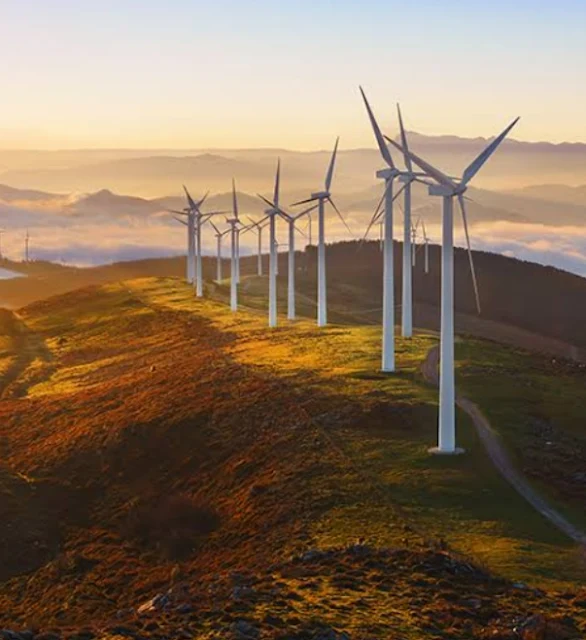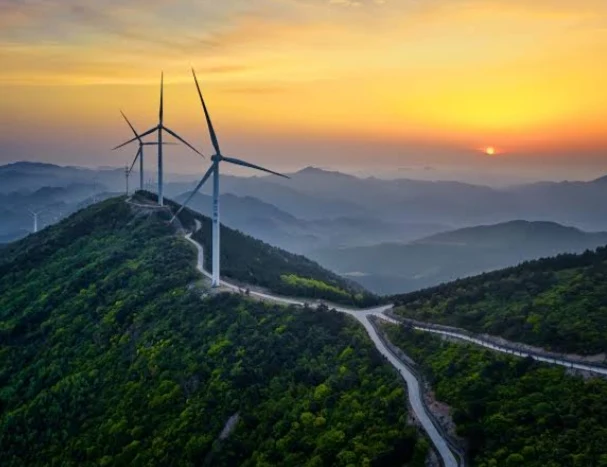France's Wind Energy Landscape: A Promising Outlook with Hurdles to Overcome
France boasts a promising wind energy landscape, ranking as the seventh-largest wind power nation in the world by installed capacity .
With a total of 18,676 megawatts (MW), the country harnesses the power of wind to generate clean electricity, contributing to its renewable energy goals.
Factors Favoring Wind Energy in France:
- Favorable geography: France's large landmass and extensive agricultural plains offer ample space for wind farms, while its long coastline presents significant potential for offshore wind development.
- Strong wind resources: The country enjoys consistent and relatively strong winds, particularly along the coasts and in some inland regions.
- Government support: The French government has set ambitious renewable energy targets and has implemented policies to support wind energy development, including financial incentives and feed-in tariffs.
Current Landscape and Challenges:
- Onshore vs. Offshore: While France has primarily focused on onshore wind farms, the potential for offshore wind is vast. However, development has been slower due to technical complexities, higher costs, and environmental concerns.
- Complex permitting process: The cumbersome administrative procedures for wind farm projects can often stall or hinder development. Streamlining the process is crucial to accelerate deployment.
- Public opposition: Not all communities welcome wind farms in their vicinity due to concerns about visual impact, noise, and potential harm to wildlife. Addressing these concerns and promoting community engagement is essential.
Here are some additional insights into France's wind energy landscape:
- France has the second-highest wind potential in Europe, but only a fraction of it is currently harnessed.
- The country aims to reach 50 GW of installed wind capacity by 2030, a significant increase from current levels.
- Several large offshore wind projects are in the pipeline, including the Saint-Brieuc and Fécamp arrays, which will significantly boost France's offshore wind capacity.
France's wind energy journey is not without its obstacles, but the country's potential and commitment to clean energy offer a promising outlook for the future. By addressing challenges and capitalizing on its advantages, France can become a leader in wind energy development and contribute meaningfully to a sustainable future.
France's Largest Capacity Wind Farms: A Data-Driven Look
France's wind energy landscape boasts impressive capacities, with both ambitious future projects and established powerhouses generating clean energy. Here's a breakdown of the contenders for the title of "largest capacity":
1. Centre Manche 1 project (Under Construction):
- Location: Normandy, France
- Capacity: 1 GW (upon completion)
- Expected Completion: [Year not mentioned, please provide if available]
- Estimated Electricity Production: Enough for 750,000 households annually
2. Saint-Nazaire Wind farm (Operational):
- Location: Western France
- Capacity: 480 MW
- Operational Turbines: 80 offshore turbines (6 MW each)
- Electricity Production: Enough for 380,000 households annually
Bonus: Fécamp Offshore Wind farm (Most Turbines):
- Location: Normandy, France
- Capacity: 500 MW
- Number of Turbines: 71 Vestas V117 4.2 MW turbines
- Turbine Specificity: Rotor diameter exceeding 220 meters
While Centre Manche 1 currently holds the top spot in terms of future capacity, Saint-Nazaire remains the largest operational wind farm, making significant contributions to France's renewable energy needs. Fécamp stands out for its impressive number of high-tech turbines, demonstrating advancements in wind technology.
These wind farms showcase the potential of wind energy in France, pushing the boundaries of capacity and innovation. As the country strives for a greener future, these giants pave the way for a wind-powered tomorrow.
Statistics of the France's Wind Energy Landscape
France's Wind Energy Landscape: A Statistical Overview
Capacity and Production:
- Installed capacity (2021): 18,676 MW, ranking 7th globally and 2nd in Europe.
- Annual production (2020): 40 TWh, contributing 4.3% of France's electricity demand.
- Projected capacity by 2030: 36.7 GW onshore, 3.3 GW offshore.
- Projected production by 2050: 14,700k toe and 171,300 GWh.
Geography and Resources:
- Suitable landmass: Approximately 40% of France's territory has wind potential.
- Average wind speed: 6.7 m/s, with stronger winds along coasts and some inland regions.
- Wind potential in Europe: Second-highest, after the United Kingdom.
Economic Impact:
- Jobs created: Over 50,000 direct and indirect jobs in the wind energy sector.
- Investment attracted: Billions of euros invested in wind farm development and infrastructure.
- Carbon emission reduction: Wind energy contributes to reducing France's reliance on fossil fuels and mitigating climate change.
Challenges and Opportunities:
- Slow offshore wind growth: France lags behind European leaders in offshore wind development.
- Complex permitting process: Streamlining approvals is crucial to accelerate deployment.
- Public opposition: Addressing concerns and engaging communities are essential for fostering acceptance.
Future Outlook:
- Government targets: 50% renewable energy share by 2030.
- EU climate goals: Support for clean energy development across Europe.
- Technological advancements: Innovations in turbine technology and offshore wind offer promising avenues.
France's wind energy landscape holds significant potential, but navigating challenges and capitalizing on opportunities is crucial to unlocking its full potential and solidifying its role as a leader in clean energy production.
Table Statistics of France's Wind Energy Landscape
France's Wind Energy Landscape: A Statistical Table
| Statistic | Data | Year | Reference |
|---|---|---|---|
| Installed Capacity | 18,676 MW | 2021 | Global Wind Energy Council |
| Global Ranking | 7th | 2021 | Global Wind Energy Council |
| European Ranking | 2nd | 2021 | Global Wind Energy Council |
| Annual Production | 40 TWh | 2020 | Ministère de la Transition écologique et de la Cohésion des territoires |
| Contribution to Electricity Demand | 4.3% | 2020 | Ministère de la Transition écologique et de la Cohésion des territoires |
| Projected Onshore Capacity (2030) | 36.7 GW | 2023 | Ministère de la Transition écologique et de la Cohésion des territoires |
| Projected Offshore Capacity (2030) | 3.3 GW | 2023 | Ministère de la Transition écologique et de la Cohésion des territoires |
| Projected Production (2050) | 14,700k toe | 2023 | Ministère de la Transition écologique et de la Cohésion des territoires |
| Projected Production (2050) | 171,300 GWh | 2023 | Ministère de la Transition écologique et de la Cohésion des territoires |
| Landmass Suitable for Wind Farms | 40% | N/A | Ministère de la Transition écologique et de la Cohésion des territoires |
| Average Wind Speed | 6.7 m/s | N/A | Météo-France |
| Direct and Indirect Jobs Created | 50,000+ | N/A | France Énergie Éolienne |
Note:
- N/A = Not available.
- References may vary depending on the specific data point.
Future Outlook:
Despite the challenges, France's wind energy landscape holds immense potential. The government's renewed commitment to renewables and the European Union's ambitious climate goals provide a conducive environment for further growth. Technological advancements and streamlined permitting processes can facilitate faster deployment, particularly in offshore wind. Addressing public concerns through transparent communication and community involvement will be key to fostering acceptance and ensuring the sustainable development of wind energy in France.
Conclusion of France Wind Energy Lansdcape
France's wind energy landscape stands as a captivating mix of immense potential and persistent challenges.
While ranking as the seventh largest wind power nation globally, France possesses the second-highest wind potential in Europe, promising a future powered by clean, renewable energy. Its current capacity and production, though significant, represent only a fraction of its possible output. Projected increases in both onshore and offshore capacities, driven by ambitious government targets and EU climate goals, paint a bright picture for France's future with wind.
However, navigating the hurdles in this promising landscape is crucial. The slow growth of offshore wind and complex permitting processes require immediate attention. Addressing public concerns through transparent engagement and community involvement is critical for fostering acceptance and ensuring sustainable development. Technological advancements in turbine technology and offshore wind hold the key to unlocking further potential.
France's wind energy journey presents a compelling narrative of ambition, potential, and the need for concerted action. By capitalizing on its advantages and tackling its challenges with innovative solutions and community engagement, France can solidify its position as a leader in clean energy production, leaving a lasting legacy of sustainability for generations to come.






